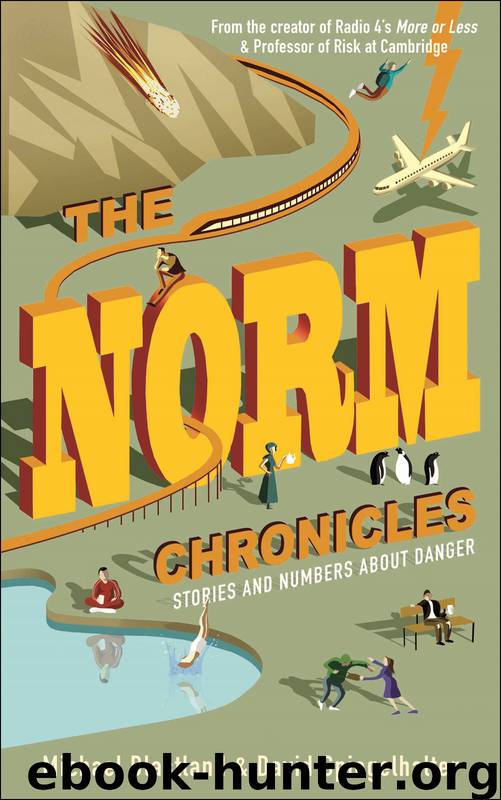The Norm Chronicles by Michael Blastland

Author:Michael Blastland
Language: eng
Format: epub
Publisher: Profile
Published: 2013-03-25T16:00:00+00:00
For calculating MicroMorts, the best data come from the US National Transportation Safety Board statistics on planes carrying at least 10 passengers.20 Looking at the ten years from 2002 to 2011, each year US commercial airlines flew an average of 10 million flights. Over that period there were no major disasters, and an average of 16 passengers and crew were killed each year of the 700 million who got on a plane – this works out as 0.02 MicroMorts per flight, or an average of 50 million flights before you are killed. So if you took one flight a day, that’s 120,000 years.
Now, you may complain that we have neatly avoided 9/11, in 2001. So if we look at 1992–2011, during which there were a number of major accidents, it works out at 0.11 MicroMorts per flight, or an average of 9 million flights before you are killed.
But how should we measure these risks so that we can compare them with different ways of travelling? By journey, by mile or by hour? Let’s use as a benchmark the somewhat pessimistic figure of a 1-in-10-million chance of being killed per flight, which is 10 flights per MicroMort. An average US commercial flight lasts 1.8 hours and travels 750 miles. So that works out as 7,500 miles or 18 hours per MicroMort, around 20 times the distance for driving in the UK, and similar to rail.
As we’ve seen, risk is not evenly spread through the flight. And if you were really going to choose transport for a trip on this basis, you would need to factor in the drive to the airport, or the cycle to the railway station and so on.
But one set of flying statistics stands out from the rest and these are a different matter: small private aircraft, known as ‘General Aviation’. There are around 220,000 registered general aviation aircraft in the US, and each year around 1,600 have accidents, about 300 of which are fatal. That’s 6 a week. On average over the last ten years, no fewer than 520 people a year were killed in small aircraft and helicopters, 97 per cent of all air fatalities.
This works out as 13 fatal accidents per 1 million hours flying, around 150 times the rate of commercial airlines. That’s around 1 MM for every 6 minutes in a small plane, travelling perhaps around 15 miles, about the same risk, per mile, as walking or cycling.
We see the same pattern in the UK: between 2000 and 2010 there were 9 fatalities on airlines, 34 in helicopters and 202 in ‘general aviation’.21 Bigger is definitely safer. So here’s a question on the front line of stats versus psychology: do pilots of small planes feel safer for being at the controls? If you know any, ask.
One last thought. Turbulence can be dangerous even if the wings stay on: 13 people were injured during turbulence in the year up to August 2012 on US commercial airlines. Of these, 12 were cabin crew.22 So when
Download
This site does not store any files on its server. We only index and link to content provided by other sites. Please contact the content providers to delete copyright contents if any and email us, we'll remove relevant links or contents immediately.
| Biomathematics | Differential Equations |
| Game Theory | Graph Theory |
| Linear Programming | Probability & Statistics |
| Statistics | Stochastic Modeling |
| Vector Analysis |
Weapons of Math Destruction by Cathy O'Neil(5032)
Factfulness: Ten Reasons We're Wrong About the World – and Why Things Are Better Than You Think by Hans Rosling(4016)
Factfulness_Ten Reasons We're Wrong About the World_and Why Things Are Better Than You Think by Hans Rosling(2751)
Descartes' Error by Antonio Damasio(2728)
A Mind For Numbers: How to Excel at Math and Science (Even If You Flunked Algebra) by Barbara Oakley(2688)
TCP IP by Todd Lammle(2633)
Applied Predictive Modeling by Max Kuhn & Kjell Johnson(2475)
Fooled by Randomness: The Hidden Role of Chance in Life and in the Markets by Nassim Nicholas Taleb(2408)
The Book of Numbers by Peter Bentley(2400)
The Tyranny of Metrics by Jerry Z. Muller(2399)
The Great Unknown by Marcus du Sautoy(2180)
Once Upon an Algorithm by Martin Erwig(2143)
Easy Algebra Step-by-Step by Sandra Luna McCune(2111)
Practical Guide To Principal Component Methods in R (Multivariate Analysis Book 2) by Alboukadel Kassambara(2089)
Lady Luck by Kristen Ashley(2067)
Police Exams Prep 2018-2019 by Kaplan Test Prep(2028)
Linear Time-Invariant Systems, Behaviors and Modules by Ulrich Oberst & Martin Scheicher & Ingrid Scheicher(1980)
All Things Reconsidered by Bill Thompson III(1957)
Secrets of Creation, Volume 1: The Mystery of the Prime Numbers by Watkins Matthew(1858)
